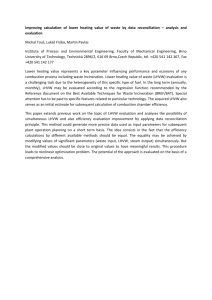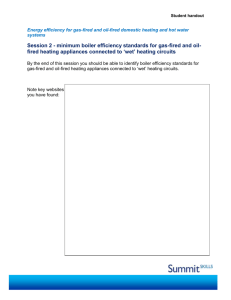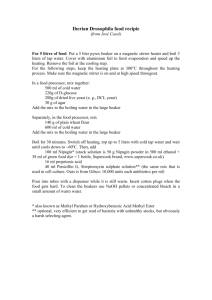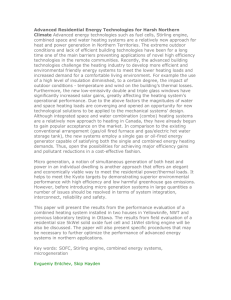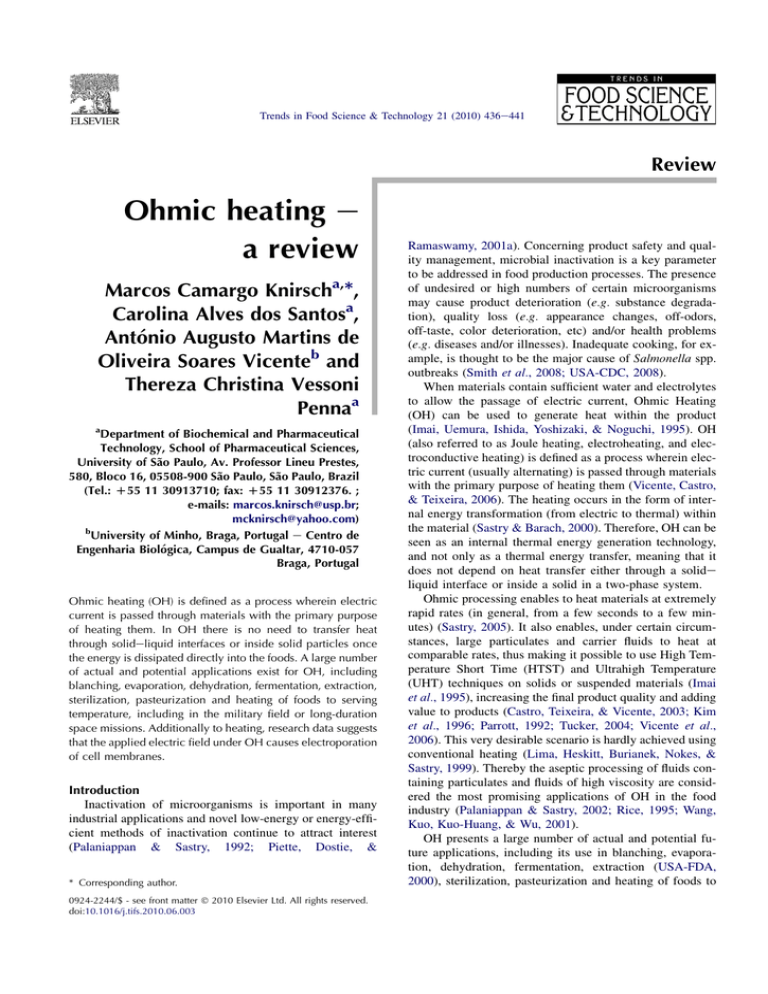
Trends in Food Science & Technology 21 (2010) 436e441
Review
Ohmic heating e
a review
Marcos Camargo Knirscha,*,
Carolina Alves dos Santosa,
António Augusto Martins de
Oliveira Soares Vicenteb and
Thereza Christina Vessoni
Pennaa
a
Department of Biochemical and Pharmaceutical
Technology, School of Pharmaceutical Sciences,
University of São Paulo, Av. Professor Lineu Prestes,
580, Bloco 16, 05508-900 São Paulo, São Paulo, Brazil
(Tel.: D55 11 30913710; fax: D55 11 30912376. ;
e-mails: marcos.knirsch@usp.br;
mcknirsch@yahoo.com)
b
University of Minho, Braga, Portugal e Centro de
Engenharia Biológica, Campus de Gualtar, 4710-057
Braga, Portugal
Ohmic heating (OH) is defined as a process wherein electric
current is passed through materials with the primary purpose
of heating them. In OH there is no need to transfer heat
through solideliquid interfaces or inside solid particles once
the energy is dissipated directly into the foods. A large number
of actual and potential applications exist for OH, including
blanching, evaporation, dehydration, fermentation, extraction,
sterilization, pasteurization and heating of foods to serving
temperature, including in the military field or long-duration
space missions. Additionally to heating, research data suggests
that the applied electric field under OH causes electroporation
of cell membranes.
Introduction
Inactivation of microorganisms is important in many
industrial applications and novel low-energy or energy-efficient methods of inactivation continue to attract interest
(Palaniappan & Sastry, 1992; Piette, Dostie, &
* Corresponding author.
0924-2244/$ - see front matter Ó 2010 Elsevier Ltd. All rights reserved.
doi:10.1016/j.tifs.2010.06.003
Ramaswamy, 2001a). Concerning product safety and quality management, microbial inactivation is a key parameter
to be addressed in food production processes. The presence
of undesired or high numbers of certain microorganisms
may cause product deterioration (e.g. substance degradation), quality loss (e.g. appearance changes, off-odors,
off-taste, color deterioration, etc) and/or health problems
(e.g. diseases and/or illnesses). Inadequate cooking, for example, is thought to be the major cause of Salmonella spp.
outbreaks (Smith et al., 2008; USA-CDC, 2008).
When materials contain sufficient water and electrolytes
to allow the passage of electric current, Ohmic Heating
(OH) can be used to generate heat within the product
(Imai, Uemura, Ishida, Yoshizaki, & Noguchi, 1995). OH
(also referred to as Joule heating, electroheating, and electroconductive heating) is defined as a process wherein electric current (usually alternating) is passed through materials
with the primary purpose of heating them (Vicente, Castro,
& Teixeira, 2006). The heating occurs in the form of internal energy transformation (from electric to thermal) within
the material (Sastry & Barach, 2000). Therefore, OH can be
seen as an internal thermal energy generation technology,
and not only as a thermal energy transfer, meaning that it
does not depend on heat transfer either through a solide
liquid interface or inside a solid in a two-phase system.
Ohmic processing enables to heat materials at extremely
rapid rates (in general, from a few seconds to a few minutes) (Sastry, 2005). It also enables, under certain circumstances, large particulates and carrier fluids to heat at
comparable rates, thus making it possible to use High Temperature Short Time (HTST) and Ultrahigh Temperature
(UHT) techniques on solids or suspended materials (Imai
et al., 1995), increasing the final product quality and adding
value to products (Castro, Teixeira, & Vicente, 2003; Kim
et al., 1996; Parrott, 1992; Tucker, 2004; Vicente et al.,
2006). This very desirable scenario is hardly achieved using
conventional heating (Lima, Heskitt, Burianek, Nokes, &
Sastry, 1999). Thereby the aseptic processing of fluids containing particulates and fluids of high viscosity are considered the most promising applications of OH in the food
industry (Palaniappan & Sastry, 2002; Rice, 1995; Wang,
Kuo, Kuo-Huang, & Wu, 2001).
OH presents a large number of actual and potential future applications, including its use in blanching, evaporation, dehydration, fermentation, extraction (USA-FDA,
2000), sterilization, pasteurization and heating of foods to
M.C. Knirsch et al. / Trends in Food Science & Technology 21 (2010) 436e441
serving temperature in the military field or long-duration
space missions (Sastry et al., 2009). Still most applications
are waiting for commercial exploitation (Sastry, 2005).
Food processing e electric conductivity, the critical
parameter
Since the main critical factor in thermal processes is the
thermal history and location of the “cold spot”, locating
cold zones during OH requires special consideration as
the current knowledge of conventional heating cannot be
extrapolated to OH technology (USA-FDA, 2000). In
a non homogeneous material, such as soups containing slices of solid foods, the electrical conductivity (s) of the particles and its relation to the fluid conductivity is pointed as
a critical parameter to the understanding of the particles’
heating rate under OH (Palaniappan & Sastry, 1991b).
Proper electric conductance management is essential to
successfully apply OH (Biss, Coombes, & Skudder, 1989;
Castro, Teixeira, Salengke, Sastry, & Vicente, 2004; Fryer
& Zhang, 1993; Wang et al., 2001).
The heating rate of particles in a fluid depends on: (i) the
relative conductivities of the system’s phases and (ii) the
relative volume of those phases (Sarang, Sastry, Gaines,
Yang, & Dunne, 2007). Low conductivity solid particles,
comparatively to the fluid conductivity, tend to lag behind
the fluid at low concentrations related to the volume of
the fluid. However, in conditions where the concentration
of the particles is high, those same low conductivity particles may heat faster than the surrounding fluid. So, the phenomenon of particle-lagging or particle-leading depends on
the significance of particle resistance to the overall circuit
resistance (Sastry & Palaniappan, 1992). This phenomenon
occurs because, with the increase of the particles’ concentration, the electric current path through the fluid becomes
more tortuous, forcing a greater percentage of the current to
flow through the particles. This can result in higher energy
generation rates within the particles and consequently in
a greater relative particle heating rate (Sarang et al.,
2007; Sastry & Palaniappan, 1992). This fact indicates
that it may be possible to adjust the heating pattern of solidefluid systems by adjusting the overall influence of particles’ resistance in the system through setting the particles
concentration in the fluid.
The electric conductivity of some systems may also be
altered to achieve the ideal OH situation, when the conductivity of the particles is equal to the surrounding fluid
(Wang & Sastry, 1993a). However, as pointed by Halden,
De Awis, and Fryer (1990) it is unlikely that the exact
same heating rate can be achieved throughout the process,
even though the thermal difference, in practical terms,
may be too small to be significant.
In fact, the electric conductivity is a function of the
structure of the material and often changes by heating
(cooking); however in some foods, the overall heating effect might be too little to alter the pattern of electrical conductivity (Pongviratchai & Park, 2007). There are also
437
critical s values below 0.01 S/m and above 10 S/m where
OH is not applicable. This is because very large voltages or
very large amperage values would be needed to generate
the amount of heat required raising temperature substantially by the Joule effect, in case of very low or very large
s values, respectively (Piette et al., 2004; Piette, Dostie, &
Ramaswamy, 2001b).
Palaniappan and Sastry (1991a) reported that the infiltration of a salt solution might increase the conductance of vegetables while, in contrast, the leaching out of ions from
vegetable tissue during immersion in water may decrease
conductance. Halden et al. (1990) monitored conductance
during the blanching of vegetables and suggested that the destruction of cell walls released cytoplasm contents thus
changing the conductance value. Later, Wang and Sastry
(1993a) suggested that the infiltration of salt solution to improve the conductance of vegetable tissue.
Increasing the electrolytic content within foods to increase electrical conductivity may be accomplished by
salt infusion via soaking or blanching of solids in salt solution. This may be used as a pretreatment for OH for particulate foods to obtain uniform heat treatment, if the
composition and other properties of the food are not greatly
affected (Palaniappan & Sastry, 1991a; Wang & Sastry,
1993a, 1993b). However, a low-temperature soaking
method has the disadvantage of being time consuming
(Sarang et al., 2007).
The possibility to alter the electrical conductivity of
solid foods by blanching pretreatment has been studied
by Sarang et al. (2007). In this study the solid constituents
of chicken chow mein (chicken, celery, bean sprouts, mushroom, water chestnuts) have been blanched in a highly conductive soy sauce at 100 C for different lengths of time to
adjust their electrical conductivity to that of the chow mein
sauce; the modifications in the electric conductivity of the
chicken and vegetables were determined. As the vegetable
tissue is heated, structural changes like cell wall breakdown, tissue damage, increase of mobile moisture, and softening occur, affecting the electrical conductivity (Wang &
Sastry, 1997). Thus heating causes more mobile moisture,
increasing ionic mobility, which in turn increases the electrical conductivity (Sarang et al., 2007). It was also observed that there was a time limit (5e6 min) beyond
which the blanching of mushroom for further processing
may cause shrinkage and loss of porosity of the material
and therefore causing a decrease of its electric conductivity.
The blanched chicken meat did not show a significant increase in conductivity: this fact is attributed to the chicken
meat behavior that typically shrinks and becomes less permeable after blanching as opposed to most vegetables tissue, which turns soft. In fact, while the ionic content is
increased in chicken after blanching, the overall ionic
mobility may be reduced due to low permeability. These
opposed effects may explain why only small increases in
the electrical conductivity could be observed for chicken
meat (Sarang et al., 2007).
438
M.C. Knirsch et al. / Trends in Food Science & Technology 21 (2010) 436e441
Therefore the material infrastructure may also interfere
in the electric conductance. Wang et al. (2001) have demonstrated that the conductance of bamboo, sugarcane, lettuce and mustard can differ if it is measured along the
stem or across it. Wang et al. (2001) argue that the difference in electric conductance measurements from the same
material should, therefore, be explained by tissue infrastructure rather than chemical composition. It was observed
that both the orientation of vascular bundles and the shape
of parenchyma cells can influence the electric conductance
in vegetables (Wang et al., 2001).
The electrical conductance readings of the same vegetables also vary pronouncedly in the literature. For example,
the electric conductance of potato can be 0.037 S/m (Kim
et al., 1996), 0.06 S/m (De Alwis, Halden, & Fryer,
1989), or 0.32 S/m (Palaniappan & Sastry, 1991a), and carrot can be 0.041 S/m (Kim et al., 1996) or 0.13 S/m
(Palaniappan & Sastry, 1991a). As mentioned before, other
than the difference in the composition of the test samples
and the methodology used, the direction for taking measurements may also be a contributing factor to the variation
(Wang et al., 2001).
Amongst the principal causes of electrical conductivity
changes in foods during OH, the destabilization of cellular
membranes is pointed to be the main responsible effect for
the reduction of the system’s impedance (An & King, 2007;
Imai et al., 1995; Lebovka, Praporscic, Ghnimi, &
Vorobiev, 2005; Pongviratchai & Park, 2007), but it is
also affected by cell rupture, cell electroporation, tissue
shrinkage, phase change, dehydration, starch gelatinization,
salt concentration and mobility, moist mobility, pH value
and the presence of fat or other non-conducting substances
(Piette et al., 2004; Pongviratchai & Park, 2007), among
other factors.
Microbial inactivation
The principal mechanisms of microbial inactivation in
OH are thermal in nature. Recent research indicates that
OH may present mild non-thermal cellular damage due to
the presence of the electric field (Cho, Yousef, & Sastry,
1999; Pereira, Martins, Mateus, Teixeira, & Vicente,
2007; Sun et al., 2008). The principal reason for the additional effect of ohmic treatment may be its low frequency
(usually 50e60 Hz), which allows cell walls to build up
charges and form pores (USA-FDA, 2000). As a main consequence of this effect, the D value observed for the microbial inactivation under ohmic heating is reduced when
compared to traditional heating methods. This reduction
has been observed for Bacillus licheniformis and Escherichia coli (Pereira et al., 2007), Bacillus subtilis (Cho
et al., 1999), Streptococcus thermophilus (Sun et al.,
2008) and Byssochlamys fulva (Castro, 2007).
Little research has been performed on the influence of
ohmic heating on microbial activity and inactivation. The
thermal treatment required for microbial inactivation in
biomaterials and foods could be potentially reduced if there
exist any sublethal injury or additional lethal effect due to
electric current (Palaniappan & Sastry, 1992).
There have been no reports of particular resistant microorganisms or pathogen strains with unique resistance to the
technology, the most resistant pathogens would likely be
the same as those for thermal processes (USA-FDA, 2000).
Pereira et al. (2007) have reported lower D and z values
for the inactivation of E. coli and B. licheniformis when
submitted to ohmic heating. In this research, comparing
conventional against ohmic heating, the thermal history
of the samples analyzed was adjusted to match. The D
values observed for E. coli at 65 C were 3.5 0.2 and
0.86 min for conventional and ohmic process respectively.
The z values were also reported as 23.1 and 8.4 C respectively. The observed results indicate that the electric current
may have affected the microbial death rate (Pereira et al.,
2007). Similar observations were obtained in the same
study for the spore inactivation of B. licheniformis. Considering both microorganisms strain, ohmic heating presented
a lower D value. This fact indicates that an additional nonthermal lethal effect occurred under ohmic heating, due to
the presence and effects of the electric current over vegetative cells of E. coli and bacterial spores of B. licheniformis
(Pereira et al., 2007).
In the study, performed by Cho et al. (1999) on the B.
subtilis and Bacillus atrophaeus inactivation kinetics by
conventional moist heating and ohmic heating, is possible
to observe that the application of an electric field leads to
lower thermal inactivation time, for the same temperature
of treatment; per example, the D value at T ¼ 92.3 C
was reduced by 1 min for ohmic heating when compared
to conventional heating by water circulation. It is possible,
therefore, to infer that the microbial inactivation was affected by the incident electric field in the medium during
the heating process.
However, Palaniappan and Sastry (1992) found no difference between the effects of ohmic and conventional
heat treatment on the death kinetics of yeast (Zygosaccharomyces bailli), under identical heating histories. In some
cases, however, a mild electrical pretreatment decreased
the subsequent inactivation requirements, for E. coli. The
authors observed only slightly lower D values for the inactivation of Zygosaccharomyces bailii and E. coli when
ohmic heating was applied at temperatures lower than
56 C. Although these D values were lower when compared
to conventional heating, a t-test comparison at 95% confidence level showed no significant statistical difference between treatments (Palaniappan & Sastry, 1992).
Milk viable aerobes and S. thermophilus inactivation
have been accessed by Sun et al. (2008). According to
the authors the observed results demonstrated that ohmic
heating causes higher microbial death than the conventional
heating process. In this study, the final microbial count and
the calculated D values for ohmic heating were significantly lower than those acquired from conventional heating, under the same temperature history conditions.
M.C. Knirsch et al. / Trends in Food Science & Technology 21 (2010) 436e441
Therefore, it was pointed that ohmic heating caused a thermal lethal effect and an additional non-thermal lethal effect
on the studied microorganisms (Sun et al., 2008). According to Sun et al. (2008) the inactivation effect of electricity
is significant compared to that of heat and was shown to be
related to the electrical voltage and frequency.
Yoon, Lee, Kim, and Lee (2002) have investigated the
effect of ohmic heating on the structure and permeability
of cell membrane of yeast cells (Saccharomyces cerevisiae). Under similar timeetemperature history, for both
conventional and ohmic heating, the authors have observed
that little differences between processes could be observed
under 50 C but the difference of yeast cell destruction rate
under ohmic heating became much pronounced at
70e80 C (Yoon et al., 2002).
Electroporation effect
Additionally to the heating promotion, research data
strongly suggests that the applied electric field under OH
causes electroporation of cell membranes. The cell electroporation is defined as the formation of pores in cell membranes due to the presence of an electric field and as
consequence, the permeability of the membrane is enhanced and material diffusion throughout the membrane
is achieved by electro-osmosis (An & King, 2007; Coster
& Zimmermann, 1975; Lima & Sastry, 1999). It is assumed
that the electric breakdown or electroporation mechanism
is dominant for the non-thermal effects of OH (An &
King, 2007; Kulshrestha & Sastry, 2003; Sensoy &
Sastry, 2004).
Yoon et al. (2002) observed that under OH the electric
field appeared to have both direct and indirect effect on
the cell wall, and intracellular materials were exuded to
the culture medium. The exudates seemed to be composed
of amino acids, protein, nucleic acids, coenzymes, and related material (Yoon et al., 2002). It is stated that, below
50 C, similar concentrations of exuded material were detected in the yeast supernatant, under conventional or OH.
However, at temperatures above 50 C, the concentration
of exuded materials from the ohmic heated groups were
higher than those from conventional groups ( p < 0.01)
and that the rate of protein exuded per unit temperature increase was found to be significantly higher ( p < 0.01) with
OH than with conventional heating. The authors hypothesized that the higher exudation rate was not only dependent
on the destruction rate of the yeast cells but also on the type
of heating method. The influence of the electrical field
within OH might have increased the rate of electroporation,
thereby leading to excess exudation and cell death. It was
also observed that the amount of exuded protein increased
significantly as the electric field increased from 10 to
20 V/cm. Spectroscopic analysis has shown that for OH
at 20 V/cm the absorbance at 260 nm typically attributed
to nucleic acids was 2-fold ( p < 0.01) and the total protein
content was 3-fold higher ( p < 0.01) when compared with
that at 15 V/cm (Yoon et al., 2002).
439
When applied at sublethal temperatures, the electroporation effect caused by the OH method has demonstrated the
potential to benefit fermentative processes. The application
of OH was studied for the fermentation of Lactobacillus
acidophilus by Cho, Yousef, and Sastry (1996) and also
by Loghavi, Sastry, and Yousef (2008, 2009). In Cho et
al.’s (1996) study, the fermentative process temperature
control was performed by conventional heating (water
bath) and by OH (at constant voltage values of 15 V or
40 V). The processes were conducted at different temperatures (30 , 35 and 40 C). It was observed that the incidence of electric field in the process may cause
membrane electroporation provoking faster and more efficient nutrient transport to the interior of the cell, thus reducing the lag phase of the fermentation. On later fermentative
stages, however, OH has demonstrated to cause productivity decrease. This decrease may also be related to the electroporation effect which possibly allows the transport of
metabolites to the interior of the cell and consequently
inhibits the fermentative process (Cho et al., 1996;
USA-FDA, 2000).
Conclusions
OH is an emerging technology with large number of actual and future applications. The possibilities for OH includes blanching, evaporation, dehydration, fermentation,
extraction, sterilization, pasteurization and heating of foods
to serving temperature, including in the military field or in
long-duration space missions. Additionally to heating, research data strongly suggests that the applied electric field
under OH causes electroporation of cell membranes.
Still more research is needed to completely understand
all the effects produced by ohmic heating. The effects of
the applied electric field, the incident electric current and
the applied electric frequency during ohmic heating over
different microorganisms and foods (at molecular and cellular level) still need to be more deeply studied. If confirmed, the electroporation effect or any other temporary
permeabilization effect on cellular membranes that occurs
during ohmic heating may have significant economic consequences to industry (Sastry, 2008). Therefore understanding, characterizing and modeling this phenomenon is
required in order to optimize and possibly exploit its
effects.
Also more research is required addressing cold-spots
identification and measurement during complex foods processing (e.g. multiphase foods). Scientific data (Orangi,
Sastry, & Li, 1998; Salengke, 2000; Sastry, 1992; Zhang
& Fryer, 1993) presents a variety of scenarios wherein
cold-spots occur but still more development in this area is
required (Sastry, 2008). Studies on modeling, prediction
and determination of the heating pattern of complex foods
are also required to assist on the design of food sterilization
or pasteurization processes and for the successful development of a final product package that enables the application
of ohmic heating.
440
M.C. Knirsch et al. / Trends in Food Science & Technology 21 (2010) 436e441
Acknowledgment
The authors thank the financial support from CAPES
(Coordenação de Aperfeiçoamento de Pessoal de Nı́vel
Superior, Brazil), CNPq (Conselho Nacional de Desenvolvimento Cientı́fico e Tecnológico, Brazil) and FAPESP
(Fundação de Amparo à Pesquisa do Estado de São Paulo,
Brazil).
References
An, H. J., & King, J. M. (2007). Thermal characteristics of ohmically
heated rice starch and rice flours. Journal of Food Science, 72(1),
C84eC88.
Biss, C. H., Coombes, S. A., & Skudder, P. J. (1989). The development
and application of ohmic heating for the continuous heating of
particulate foodstuffs. In J. A. Field, & J. A. Howell (Eds.), Process
engineering in the food industry (pp. 11e20). London UK: Elsevier.
Castro, I. (2007). Ohmic heating as an alternative to conventional
thermal treatment. PhD. Dissertation, Portugal: Universidade do
Minho.
Castro, I., Teixeira, J. A., Salengke, S., Sastry, S. K., & Vicente, A. A.
(2004). Ohmic heating of strawberry products: electrical conductivity measurements and ascorbic acid degradation kinetics. Innovative Food Science and Emerging Technologies, 5, 27e36.
Castro, I., Teixeira, J. A., & Vicente, A. A. (2003). The influence of field
strength, sugar and solid content on electrical conductivity of
strawberry products. Journal of Food Process Engineering, 26,
17e29.
Cho, H. Y., Yousef, A. E., & Sastry, S. K. (1996). Growth kinetics of
Lactobacillus acidophilus under ohmic heating. Biotechnology and
Bioengineer, 49(3), 334e340.
Cho, H. Y., Yousef, A. E., & Sastry, S. K. (1999). Kinetics of inactivation
of Bacillus subtilis spores by continuous or intermittent ohmic and
conventional heating. Biotechnology and Bioengineer, 62(3),
368e372.
Coster, H. G., & Zimmermann, U. (1975). The mechanism of electric
breakdown in membranes of Valonia utricularis. Journal of Membrane Biology, 22, 73e90.
De Alwis, A. A. P., Halden, K., & Fryer, P. J. (1989). Shape and conductivity effects in the ohmic heating of foods. Chemical Engineering Research and Design, 67, 159e168.
Fryer, P., & Zhang, L. (1993). Electrical resistance heating of foods.
Trends in Food Science and Technology, 4(11), 364e369.
Halden, K., De Awis, A. A. P., & Fryer, P. J. (1990). Changes in the
electrical conductivity of foods during ohmic heating. Internatinal
Journal of Food Science and Technology, 25, 9e25.
Imai, T., Uemura, K., Ishida, N., Yoshizaki, S., & Noguchi, A. (1995).
Ohmic heating of Japanese White Radish Raphanus sativus L. International Journal of Food Science and Technology, 30, 461e472.
Kim, H. J., Choi, Y. M., Yang, T. C. S., Taub, I. A., Tempest, P.,
Skudder, P., et al. (1996). Validation of OH for quality enhancement of food products. Food Technology, 50, 253e261.
Kulshrestha, S., & Sastry, S. K. (2003). Frequency and voltage effects on
enhanced diffusion during moderate electric field (MEF) treatment.
Innovative Food Science and Emerging Technologies, 4(2),
189e194.
Lebovka, N. I., Praporscic, I., Ghnimi, S., & Vorobiev, E. (2005). Does
electroporation occur during the ohmic heating of food? Journal of
Food Science, 70(5), E308eE311.
Lima, M., Heskitt, B. F., Burianek, L. L., Nokes, S. E., & Sastry, S. K.
(1999). Ascorbic acid degradation kinetics during conventional
and ohmic heating. Journal of Food Preservation, 23, 421e434.
Lima, M., & Sastry, S. K. (1999). The effects of ohmic heating frequency
on hot-air drying rate and juice yield. Journal of Food Engineering,
41, 115e119.
Loghavi, L., Sastry, S. K., & Yousef, A. E. (2008). Effect of moderate
electric field frequency on growth kinetics and metabolic activity
of Lactobacillus acidophilus. Biotechnology Progress, 24,
148e153.
Loghavi, L., Sastry, S. K., & Yousef, A. E. (2009). Effects of moderate
electric field frequency and growth stage on the cell membrane
permeability of Lactobacillus acidophilus. Biotechnology Progress,
25(1), 85e94.
Orangi, S., Sastry, S. K., & Li, Q. (1998). A numerical investigation of
electroconductive heating of solideliquid mixtures. International
Journal of Heat Mass Transfer, 41(14), 2211e2220.
Palaniappan, S., & Sastry, S. (2002). Ohmic heating. In V. K. Juneja, &
J. N. Sofos (Eds.), Control of foodborne microorganisms
(pp. 451e460). New York: Marcel Dekker.
Palaniappan, S., & Sastry, S. K. (1991a). Electrical conductivities of
selected solid foods during ohmic heating. Journal of Food Process
Engineering, 14, 221e236.
Palaniappan, S., & Sastry, S. K. (1991b). Electrical conductivity of selected juices: influences of temperature, solids content, applied
voltage, and particle size. Journal of Food Process Engineering, 14,
247e260.
Palaniappan, S., & Sastry, S. K. (1992). Effects of electroconductive
heat treatment and electrical pretreatment on thermal death
kinetics of selected microorganisms. Biotechnology and Bioengineering, 39, 225e232.
Parrott, D. L. (1992). Use of OH for aseptic processing of food particulates. Food Technology, 45, 68e72.
Pereira, R., Martins, J., Mateus, C., Teixeira, J. A., & Vicente, A. A.
(2007). Death kinetics of Escherichia coli in goat milk and Bacillus
licheniformis in cloudberry jam treated by ohmic heating. Chemical Papers, 61(2), 121e126.
Piette, G., Buteau, M. L., De Halleux, D., Chiu, L., Raymond, Y.,
Ramaswamy, H. S., et al. (2004). Ohmic heating of processed meat
and its effects on product quality. Journal of Food Science, 69(2),
FEP71eFEP77.
Piette, G., Dostie, M., & Ramaswamy, H. S. (2001a). Is there a future
for ohmic cooking in meat processing? Canadian Meat Science
Association News, May 2001, 8e10.
Piette, G., Dostie, M., & Ramaswamy, H. S. (2001b). Ohmic cooking of
processed meats e state of art and prospects. Procedures of the International Congress of Meat Science and Technology, 47, 62e67.
Pongviratchai, P., & Park, J. W. (2007). Electrical conductivity and
physical properties of Surimi-Potato starch under ohmic heating.
Journal of Food Science, 72(9), E503eE507.
Rice, J. (1995). Ohmic adventures. Food Processing, 56(3), 87e91.
Salengke, S. (2000). Electrothermal effects of ohmic heating on biomaterials: Temperature monitoring, heating of solideliquid mixtures, and pretreatment effects on drying rate and oil uptake. Ph.D.
Dissertation. United States of America: The Ohio State University.
Sarang, S., Sastry, S. K., Gaines, J., Yang, T. C. S., & Dunne, P. (2007).
Product formulation for ohmic heating: blanching as a pretreatment method to improve uniformity in heating of solid-liquid food
mixtures. Journal of Food Science E: Food Engineering and Physical
Properties, 72(5), E227eE234.
Sastry, S. K. (1992). A model for heating of liquid-particle mixtures in
a continuous flow ohmic heater. Journal of Food Process Engineering, 15(4), 263e278.
Sastry, S. K. (2005). Advances in ohmic heating and moderate electric
field (MEF) processing. In G. V. Barbosa-Cánovas, M. S. Tapia, &
M. P. Cano (Eds.), Novel food processing technologies. Boce Raton,
FL: CRC Press.
Sastry, S. K. (2008). Ohmic heating and moderate electric fields processing. Food Science and Technology International, 14, 419.
Sastry, S. K., & Barach, J. T. (2000). Ohmic and inductive heating.
Journal of Food Science Supplement, 65(4), 42e46.
Sastry, S. K., Jun, S., Somavat, R., Samaranayake, C., Yousef, A., &
Pandit, R. B. (2009). Heating and sterilization technology for long-
M.C. Knirsch et al. / Trends in Food Science & Technology 21 (2010) 436e441
duration space missions. Interdisciplinary Transport Phenomena:
Annals of NY Academy of Sciences, 1161, 562e569. doi:10.1111/
j.1749-6632.2009.04088.x.
Sastry, S. K., & Palaniappan, S. (1992). Mathematical modeling and
experimental studies on ohmic heating of liquid-particle mixtures
in a static heater. Journal of Food Engineering, 15, 241e261.
Sensoy, I., & Sastry, S. K. (2004). Extraction using moderate electric
fields. Journal of Food Science, 69, 7e13.
Smith, K. E., Medus, C., Meyer, S. D., Boxrud, D. J., Leano, F.,
Hedberg, C. W., et al. (2008). Outbreaks of salmonellosis in Minnesota (1998 through 2006) associated with frozen, microwaveable, breaded, stuffed chicken products. Journal of Food
Protection, 71(10), 2153e2160.
Sun, H. X., Kawamura, S., Himoto, J. I., Itoh, K., Wada, T., & Kimura, T.
(2008). Effects of ohmic heating on microbial counts and denaturation of
proteins in milk. Food Science and Technology Research, 14, 117e123.
Tucker, G. S. (2004). Food waste management and value-added
products: using the process to add value to heat-treated products.
Journal of Food Science, 69(3), CRH102eCRH104.
USA-CDC. United States of America. Department of Health and Human Services. Centers for Disease Control and Prevention. (2008).
Multistate outbreak of Salmonella infections associated with frozen
pot pieseUnited States, 2007. MMWR Morb Mortal Wkly Rep.
Nov 28, 57(47), 1277e1280.
USA-FDA. United States of America, Food and Drug Administration,
Center for Food Safety and Applied Nutrition (2000). Kinetics of
microbial inactivation for alternative food processing technologies:
441
ohmic and inductive heating. http://www.cfsan.fda.gov/wcomm/
ift-ohm.html. at: February 17th, 2009.
Vicente, A. A., Castro, I., & Teixeira, J. A. (2006). Innovations in
thermal food processes. In Da-Wen Sun (Ed.), Thermal food processing: New technologies and quality issues (pp. 424e468). Boca
Raton, FL, USA: CRC Press, Taylor & Francis Group.
Wang, C. S., Kuo, S. Z., Kuo-Huang, L. L., & Wu, J. S. B. (2001). Effect
of tissue infrastructure on electric conductance of vegetable stems.
Journal of Food Science: Food Engineering and Physical Properties,
66(2), 284e288.
Wang, W., & Sastry, S. (1993a). Salt diffusion into vegetables tissue as
a pretreatment for ohmic heating: electrical conductivity profiles
and vacuum infusion studies. Journal of Food Engineering, 20,
299e309.
Wang, W., & Sastry, S. (1993b). Salt diffusion into vegetable tissue as
a pretreatment for ohmic heating: determination of parameters and
mathematical model verification. Journal of Food Engineering, 20,
311e323.
Wang, W., & Sastry, S. (1997). Changes in electrical conductivity of
selected vegetables during multiple thermal treatments. Journal of
Food Process Engineering, 20, 449e516.
Yoon, S. W., Lee, C. Y. J., Kim, K. M., & Lee, C. H. (2002). Leakage of
cellular material from Saccharomycies cerevisiae by ohmic heating. Journal of Microbiology and Biotechnology, 12, 183e188.
Zhang, L., & Fryer, P. J. (1993). Models for the electrical heating of
solideliquid food mixtures. Chemical Engineering Science, 48,
633e643.


